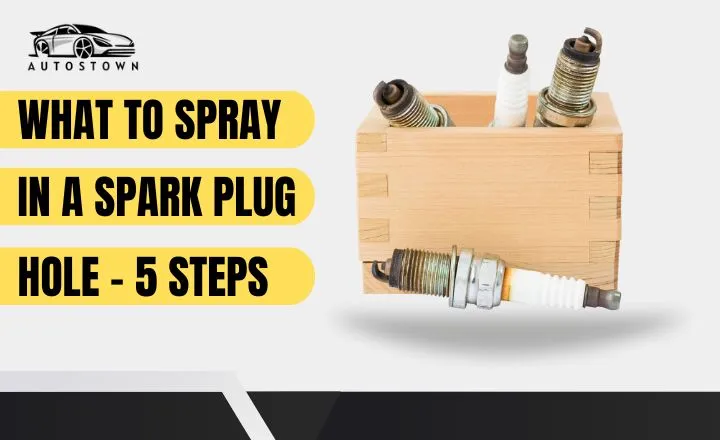Spark plugs are crucial for maintaining the functionality and longevity of the engine in your car. Over time, these vital parts may accumulate dust or deteriorate, leading to issues like misfires, poor fuel efficiency, and even engine damage. One fantastic method for cleaning and safeguarding your spark plugs is to use specialized sprays made for this reason.
In this post, we will look at five alternative methods of What To Spray In a Spark Plug Hole to increase engine performance. This comprehensive guide will provide insights into numerous items available on the market today, whether you are a car enthusiast looking for ways to increase the power of your vehicle or a DIY technician looking for cost-effective solutions for spark plug maintenance.
Why Spraying in Spark Plug Hole is Important
For starters, carbon deposits can accumulate around the spark plugs over time, making them harder to remove. This might lead to cracked or damaged plugs, which can be costly to fix.
Spraying oil or penetrating fluid into the spark plug hole beforehand, on the other hand, efficiently loosens any carbon buildup and lubricates the threads. This makes removing the plugs without using excessive force easier. Second, spraying in the spark plug hole helps to prevent corrosion.
What To Spray In A Spark Plug Hole (Step-by-Step)
Maintaining the condition of your vehicle’s spark plugs is critical for achieving peak engine performance. Carbon buildup in the spark plug hole is a typical problem that can lead to misfires and lower fuel economy. Fortunately, there are practical answers to this problem. What to spray in a spark plug hole to ensure smooth ignition and to increase the life of your spark plugs.
Option 1: Spray WD-40 in spark plug hole
When it comes to lubrication and rust prevention, WD-40 is a well-known brand. This adaptable chemical has long been trusted by mechanics and do-it-yourselfers because of its ability to penetrate and lubricate various metal surfaces. However, did you know that the spark plug hole may be cleaned up with WD-40? Yes, you read that correctly! Spraying a tiny amount of WD-40 into the spark plug hole can aid in the removal of stuck or rusty spark plugs.
The high penetrating abilities of WD-40 are the main justification for employing it in the spark plug hole. Spark plugs might over time become seized or challenging to remove due to moisture and rust. When WD-40 is sprayed into the spark plug hole, it may pass through any dirt or rust buildup and do its magic on the plug thread.
Option 2: Brake cleaner for removing residue and debris
Brake cleaner is a dependable option for removing dirt and debris from your spark plug hole. This potent spray is specifically intended to remove grease, oil, grime, and other tough pollutants that might build up over time. Brake cleaner’s fast-drying solution effectively removes undesirable residues without leaving any traces.
Remove the spark plug wire and carefully detach the spark plug to use the brake cleaner in the spark plug hole. Wear gloves and safety goggles before spraying the cleaner into the hole to protect your eyes and skin.
Squeeze the brake cleaner canister nozzle firmly to release a steady stream of cleaning agents as you position it close to the spark plug hole’s aperture. Give the brake cleaner a few minutes to permeate and dissolve any buildup inside the hole.
Option 3: Ignition coil spray for improved performance
The use of an ignition coil spray is strongly advised. The purpose of this aerosol product is to enhance electrical conductivity, prevent corrosion, and minimize misfires. Spraying this solution into the spark plug hole will remove any dirt or debris that has gathered there, ensuring a stronger connection between your spark plugs and ignition coils.
Using an ignition coil spray can have several advantages for the performance of your car. For starters, it increases fuel efficiency by assuring a more effective combustion process. This results in smoother acceleration and higher power output.
Read More:- How To Test A Spark Plug With A Battery?
Option 4: Anti-seize lubricant for easy removal
One of the most difficult aspects of maintaining your vehicle’s spark plugs is removing them without causing damage. This is where an anti-seize lubricant can help. This amazing solution includes a protective covering that keeps the plug from seizing or staying inside the hole, making removal a joy.
A special anti-seize lubricant is designed to withstand high temperatures and pressures, making sure that your spark plugs are still simple to remove even after extensive use. By applying this lubricant prior to installing new spark plugs, you can significantly lower the likelihood of future issues. The better composition helps to prevent corrosion and rust formation inside the plug hole as well as enable removal, extending the lifespan of your spark plugs and preserving peak engine performance.
Option 5: Dielectric grease for electrical insulation
Dielectric grease is a vital electrical insulating substance for boosting the efficiency and lifespan of the spark plugs in your car. It has excellent insulating qualities and acts as a barrier against corrosion and moisture. Before installing a replacement plug, coat the interior of the spark plug hole with a thin layer of dielectric grease to prevent rusting and ensure a proper seal between the plug and the engine block.
This grease performs several functions in spark plug maintenance. For starters, it prevents electrical current leakage by forming a non-conductive barrier surrounding the spark plug wire connector. This is especially essential in high-performance engines, where any current loss might result in misfires or lower power production. Second, dielectric grease protects against moisture penetration into the spark plug hole itself.
Are Spark Plugs Supposed to be Wet?
No, when conducting an inspection or troubleshooting an engine issue, you must quickly determine the root cause if you notice moist spark plugs. Fuel flooding from problems like a broken carburetor or fuel injector is a common cause of wet spark plugs. In this instance, extra fuel builds up in the combustion chamber, sopping the plugs. Other possible causes include fractured or blown cylinder heads or coolant leaking into the cylinders from the head gasket. Regardless of the cause of wet spark plugs, it’s critical to take action right away to prevent more damage.
Conclusion: Choose the right spray for optimal results.
Finally, the key to getting the greatest results is choosing the right spray for your spark plug hole. Choosing the appropriate spray can make or break your engine’s performance, whether you’re trying to fix a clogged spark plug or prevent future issues. There are many substitutes available on the market, ranging from silicone sprays to penetrating oils. Consider qualities like lubrication, cleaning prowess, and heat resistance while making your decision. By taking the time to study and buy the appropriate spray for your particular needs, you can maintain the cleanliness and functionality of your spark plug hole. To keep your engine running smoothly for years to come, don’t wait to make an investment in a high-quality spray. Do it now.
FAQs
1. Why should I spray something in a spark plug hole?
Spraying a lubricant or penetrating oil in the spark plug hole can help loosen stuck or seized spark plugs, making them easier to remove
2. What kind of spray should I use for a spark plug hole?
It is recommended to use a specialized penetrating oil that is designed to break through rust and corrosion, such as WD-40 or PB Blaster.
3. How do I apply the spray in the spark plug hole?
Remove the spark plug wire and insert the straw applicator into the hole. Spray a liberal amount of the penetrating oil directly into the hole, ensuring it reaches the threads of the spark plug.
4. Can spraying something in the spark plug hole damage my engine?
When done correctly, spraying a lubricant in the spark plug hole should not cause any damage to your engine. However, it’s important to avoid over-saturating or flooding the cylinder with excessive amounts of spray.
5. How long should I let the spray sit in the spark plug hole?
Allowing the penetrating oil to soak for at least 15-30 minutes will give it enough time to penetrate and loosen any corrosion around the spark plug.
6. Can I spray starter fluid in the spark plug hole
Yes, when you’re having trouble starting the engine, starter fluid can help ignite the engine and get it running.
7. Is it possible to spray brake cleaner into the spark plug hole
The recommendation is not to spray brake cleaner into the spark plug hole immediately.
This Might Be Also Helpful:- How To Clean Jeep Soft Top Windows?

